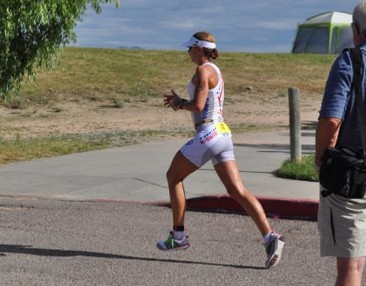Leslie asked me recently over on facebook what my philosophy was on brick workouts. Here is some quick background if you are new to triathlon training. A brick workout is a training session for multisport with at least two different sport sessions back-to-back.
Most commonly it is reference to a bike-run, but it can be any two (or more) sports. (Check out this post for some background on how the term brick may have come about.)
If you are an athlete competing in a multisport event, you will want to train with brick workouts because it gets you used to the transitions involved. (Tip: Practice your transitions often!)
When you run immediately after a bike ride, your legs might just feel, well, a bit weird. Hang in there and within about ten minutes or a mile they’ll probably feel more like running legs again.

I am assuming when Leslie asks about my brick philosophy she means how often should one do brick workouts, and how long should those workouts be? I am going to keep the discussion limited to bike-run bricks, as these are the most common and it’s often more challenging to do swim-bike bricks on a regular basis. Though if you are able to set your bike up on a trainer on a pool deck, you can get some solid swim-bike training that way.
How Often?
As you get closer to your race, starting about 3 or so months out, you should do a bike-run brick once a week. The more you get your legs used to running off the bike, the better.
Note: Your bike and bike fit will impact your transition to the run. For example, someone riding a mountain bike (upright) will most likely find the first mile or so of the run a lot more challenging than someone on a Time Trial or Triathlon specific bike. The position affects the muscles being utilize to generate force. If you are using similar muscles cycling and running, as you do when you are more upright on a mountain bike, the run will feel harder. Engaging muscles slightly differently, as you do on a TT bike, transitioning to the run will be easier.
If you can run off the bike more often, a quick 10 minute easy transition run after a quality bike session will work.

How Long?
I actually don’t have my athletes doing too many long bike-run bricks, meaning a long ride and then a long run (an hour or longer). A few such workouts are important to dial in nutrition and hydration strategies, but 30-45 minute runs off the bike, even for long course athletes are fine. You can get a quality long run in on another day.
We can summarize my brick philosophy as:
- Do them regularly, at least once a week as you get closer to your race
- Most of them can just have short (10-30 minute) transition runs
- You only need a few longer runs off the bike to help you dial in your pacing and fueling/hydration strategy.
I definitely believe that if you work on getting stronger on the bike, your run off the bike will get stronger, too. Here’s a post I wrote a while back about the secrets to running well off the bike.
Some other things to keep in mind when you are looking at brick workouts are your total workload for the week (volume and intensity) and your ability to recover from the workout(s).
Make sure you understand the purpose of your brick workout. Is it just to get the feel for running off the bike, is it to practice your transition, or are you doing race pace simulation work?
Keep Great Form
When you run off the bike, always think about maintaining great running form. We tend to get hunched over because our hip flexors are contracted when we are on the bike. Our legs can feel like they are filled with lead (or bricks!) so keep that turnover high. One mantra that you might have in your head as your start your run may be “stand tall, quick feet.”
Brick workouts are definitely important part of triathlon training and should be done regularly. And the double or triple brick (bike – run – bike – run – bike – run) can be great training sessions for all multisport athletes!
- Now it’s your turn to submit a question for me to answer on Ask the Coach.






